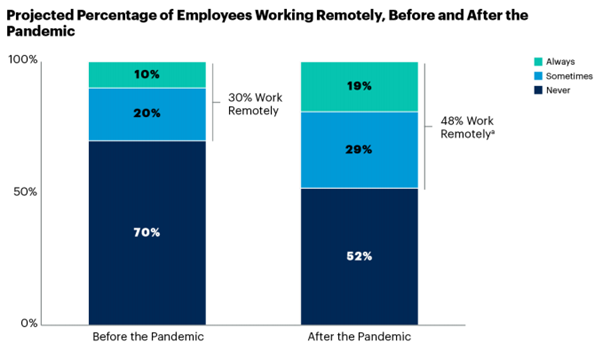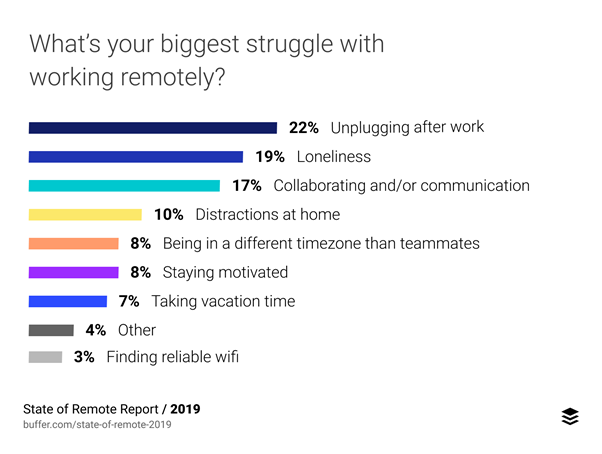Remote working statistics you need to know in 2026
As organizations have now fully embraced remote work, at Intuition we wanted to gain a better understanding of the numbers behind this work-model shift.
During this research, it became clear that the shift to virtual has brought about a series of significant advancements in the business world, such as:
- The adoption of remote work as a mainstream business model
- Emerging benefits as a result of remote work, most notably increased employee and company productivity
- A shift in business leaders’ perceptions of remote work and what this means for the business
- An uptick in both the uptake and need for workplace learning
- An increased emphasis on employee overall health and wellness
- Shifts in thoughts around talent acquisition and retention in response to this new way of working
This article looks at key stats within each of the above areas.
Scroll to learn more.
General stats on remote working
1. Nearly half of employees worked remotely full-time during the pandemic
2. The amount of employees working remotely prior to the pandemic was 30%, compared to 48% now
3. 48% of employees have kept working remotely posy pandemic
4. Modern employees would choose to spend 40% of their time working from home
5. 62% of employees expect their employers will allow them to work remotely moving forward

Source: Gartner
Stats on remote working benefits
6. 83% of employees report they are more productive working from home
7. 77% of employees say that working remotely will help their company lower operating costs
8. 78% of remote employees agree they want to work remotely to avoid distractions
9. 27% of employers have reported increased company productivity
10. The shift to remote working makes work more flexible, with 43% of CEOs in one survey granting employees flexi-days
Stats for business leaders
11. 47% of company leaders in one survey allowed employees to work from home full time after the pandemic
12. 78% of a group of 669 CEOs believe remote collaboration has to be thought of as a long-term business strategy
13. When asked what their biggest concern is in relation to the hybrid working model, 30% of business leaders replied with ‘maintaining corporate culture’
14. 61% of business leaders have implemented more frequent manager-employee check-ins since the shift to a remote/hybrid working model
15. 29% of business leaders have not taken any measures to track productivity remotely
Stats on eLearning
16. In 2020, 87% of millennials and 69% of non-millennials considered career development to be an important part of a job
17. Employees deliver $30 of increased productivity for every $1 invested in e-learning
18. Using corporate e-learning results in an increase of 18% in employee engagement
19. 82% of organizations conduct some of their compliance training online
20. 94% of employees say that they would be more willing to stay in those corporations that prioritize and invest in employee career development
Stats on health and wellness
21. 91.5% of remote workers in one survey engage in regular wellness activities (compared to 81.5% of onsite workers)
22. Engaging in wellness activities can increase productivity in workers who have been isolated from family and friends by 24%
23. 91% of remote workers who experienced increased efficiency and productivity at work regularly engaged in wellness activities
24. 80% of remote workers would consider quitting their current position for a job that focused more on employees’ mental health
25. 75% of U.S. workers have struggled at work due to anxiety since 2020

Source: Buffer
Stats on talent acquisition and retention
26. 65% of respondents in one survey report wanting to be full-time remote employees
27. 31% of remote employees during the pandemic wanted a hybrid remote work environment moving forward
28. 81% of respondents in one study said they would be more loyal to their employer if they had flexible work options
29. Remote employees are more likely to report being satisfied with their jobs than office-based workers (57% vs. 50%)
30. Remote workers are 13% more likely to stay in their jobs than onsite workers
Conclusion
Whether you are looking for information on how to manage your workforce going forward, or are interested in the key areas your employees deem important in this tumultuous world, the above evidence will help you gain a better understanding of key business areas related to remote working.
If workforce learning and development is one of the key areas you would like to focus on for the year ahead, Intuition can help.
With over 35 years’ experience in the corporate learning industry, Intuition provides an array of learning solutions to some of the largest organizations in the world.
If you would like to speak to a learning consultant about an upcoming project, please click the button below.

References
- https://www.gartner.com/en/newsroom/press-releases/2020-07-14-gartner-survey-reveals-82-percent-of-company-leaders-plan-to-allow-employees-to-work-remotely-some-of-the-time
- https://www.pwc.com/gx/en/ceo-agenda/ceo-panel-survey-emerge-stronger.pdf
- https://www.virtualvocations.com/blog/annual-statistical-remote-work-reports/remote-work-wellness-survey-report-2020/#:~:text=Respondents%20who%20work%20from%20home,onsite%20workers%20(81.58%25).
- https://buffer.com/state-of-remote-work-2019
- https://www.telusinternational.com/
- https://www.flexjobs.com/blog/post/remote-work-statistics/#:~:text=Despite%20a%20tumultuous%20year%20in,50%25).
- https://www.bcg.com/publications/2020/valuable-productivity-gains-covid-19
- https://marketingassets.staples.com/m/5644f1362b2dfad2/original/Staples-Workplace-Survey-2019.pdf
- https://emtemp.gcom.cloud/ngw/globalassets/en/human-resources/documents/trends/remote-work-after-covid.pdf
- https://www.cnbc.com/2020/05/26/who-is-happiest-working-from-home-heres-what-latest-jobs-data-says.html
- https://e-student.org/e-learning-statistics/#corporate-e-learning-statistics
- https://www.predictiveindex.com/blog/remote-work-improves-employee-productivity-happiness-retention/#:~:text=Remote%20work%20improves%20employee%20loyalty%20and%20retention.&text=Not%20only%20does%20offering%20remote,to%20stay%20than%20onsite%20workers.

